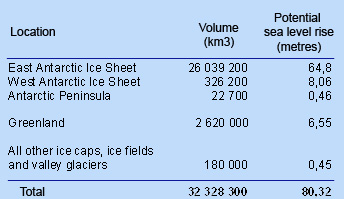
Since
1850 the glaciers of the European Alps have lost about 30 to 40% of
their surface area and about half of their volume. However, the range
of extremes observed on individual glaciers is roughly one order of
magnitude higher than the mean value of length or mass changes. (TOPtoTOP)
This constitutes the largest measured contribution to rising sea levels by glacial melt |
The Greenland Ice Sheet is also experiencing increased melting. The area that experiences some melting has increased by about 16% between 1979 and 2002. (http://www.acia.uaf.edu/) The area of melting reached unprecedented levels in 2002. Glacier shrinkage
seems to have accelerated during the last years, and the glaciers appear
to evolve at a high rate of change towards or even beyond the "warm"
limit of natural holocene (=actual warm period after last ice age) glacier
variability. (TOPtoTOP)
|